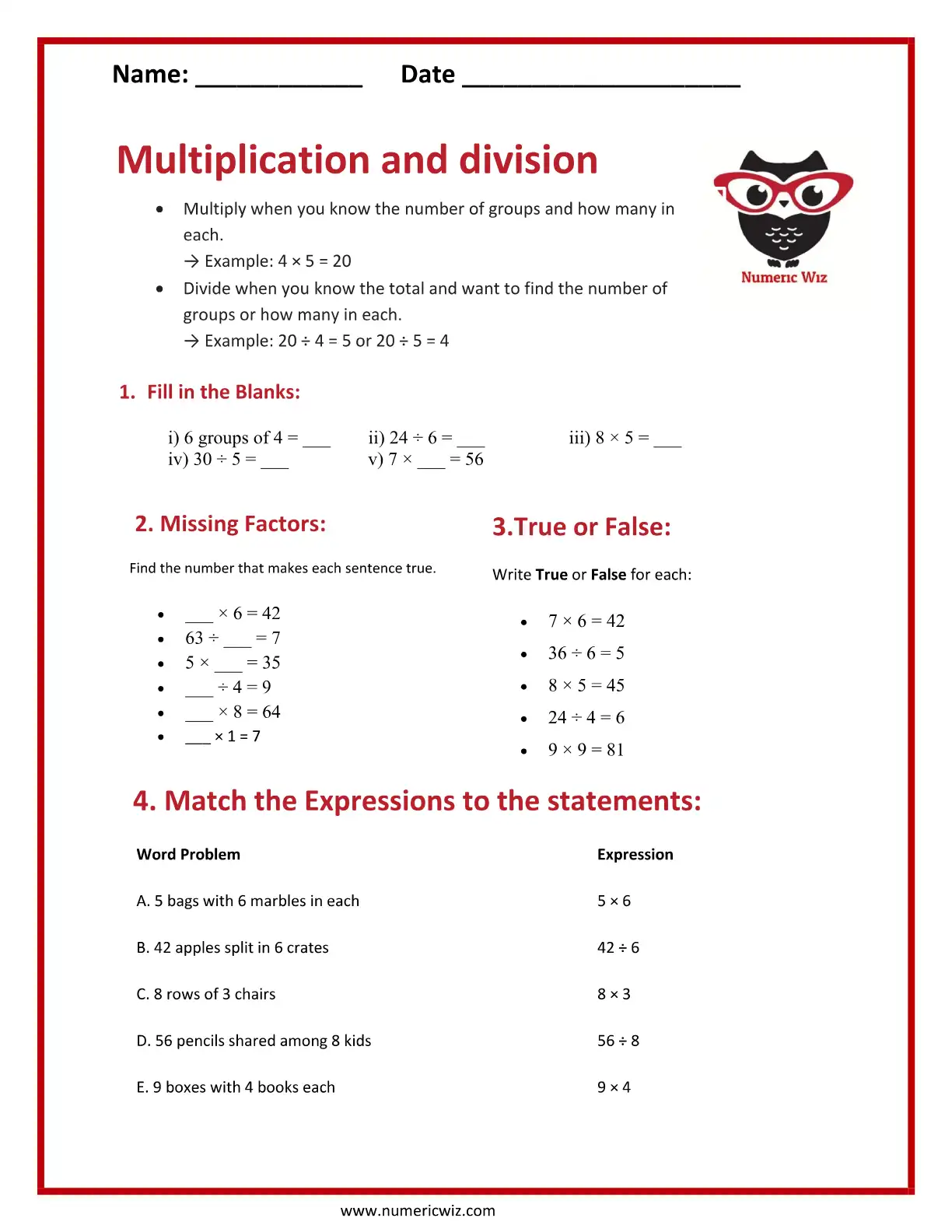The connection between multiplication and division
How to solve problems using equal groups
How to find missing numbers using logic
Confidence in switching between operations with understanding

This colorful and interactive worksheet helps Grade 3 students understand how multiplication and division are connected—and how we use them every day! Whether it’s packing bags, arranging chairs, or sharing apples, multiplication and division are powerful tools for solving real-world problems quickly and fairly.
 Through fun and structured activities like fill-in-the-blanks, finding missing factors, true/false questions, and word problem matching, this worksheet builds confidence and fluency in a friendly, step-by-step way.
Through fun and structured activities like fill-in-the-blanks, finding missing factors, true/false questions, and word problem matching, this worksheet builds confidence and fluency in a friendly, step-by-step way.
Multiplication is repeated addition—putting equal groups together. Division is splitting a total into equal groups or finding how many are in each group. These two operations go hand-in-hand and help us understand how numbers relate to one another.
Understanding this relationship lays the foundation for future skills in math like fractions, algebra, and problem-solving.
Fill in the blanks to complete multiplication and division facts
Missing factors practice to strengthen understanding of number patterns
True or false questions to help spot and fix common mistakes
Real-world word problems matched with the right expressions
4 × 7 = ?
Think: 4 groups of 7 → 7 + 7 + 7 + 7 = 28. Answer: 28
24 ÷ 6 = ?
Think: 24 items shared equally among 6 people → each gets 4. Answer: 4
5 × 8 = 40 → 40 ÷ 5 = ?
Multiplication gives 40; division reverses it. Answer: 8
This worksheet is built to move students from supported practice to independent skill. For each stage below you’ll find teacher actions, student actions, and a clear step-by-step method students can follow when solving problems.

Teacher action: Demonstrate with manipulatives (counters, cubes) and a visual (array or drawing).
Student action: Watch, respond to teacher prompts, repeat steps aloud.
Method to model (multiplication):
Read the question; identify number of groups and size of each group.
Build an array or draw groups.
Count total using repeated addition or skip-counting.
Write the multiplication sentence and the answer.
Check by asking: “If I split this total into equal groups, do I get the same group size?” (use division to check)
Method to model (division):
Read the question; find the total and number of groups (or group size).
Use counters and distribute one by one into groups.
Count how many each group has — that is the quotient.
Write the division sentence and answer.
Check by multiplying quotient × group size = total.
Teacher action: Give similar problems; prompt students through each step.
Student action: Solve with hints, draw pictures/arrays, explain reasoning.
Step prompts teachers can use: “How many groups? How many in each group? Can you draw it? Try skip-counting.”
Encourage students to always label what the question asks (total, per-group, number of groups).
Student action: Solve problems independently, follow the same 4–5 step method practiced earlier.
Self-check routine: After solving, students should use the inverse operation to confirm (multiply to check division; divide to check multiplication when appropriate).
Teacher action: Present mixed word problems and one- or two-step tasks.
Student action: Decide whether to multiply or divide, show work (drawing or number sentence), and explain solution in words.
Tips for word problems (student method):
Read carefully and underline numbers and question.
Ask: “Do I need to group or share?” Decide operation.
Model with drawing or counters.
Compute and write the equation.
Check: Does the answer make sense? Use the inverse operation or estimation.
“What is the question asking you to find?”
“Can you draw the groups?”
“Show me how you checked your answer.”
“Could you solve this the other way (use inverse)?”
Multiplication and division are used everywhere! Students will relate these concepts to:
Shopping (e.g., how many items in total?)
Sports teams (e.g., how many players per team?)
Seating arrangements
Cooking and recipes
Organizing into groups at school, at home, or in events
Think you’ve cracked it?
Download the worksheet, solve it, and upload your answers to our “Evaluate Your Work” page. Our awesome teachers will check it and send feedback just for you! Homework has never been this fun—or this helpful!
For a limited time
